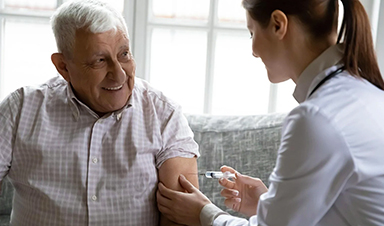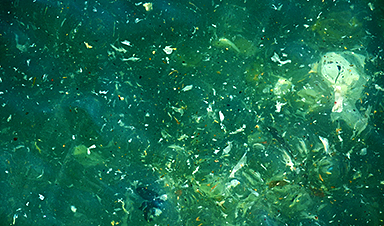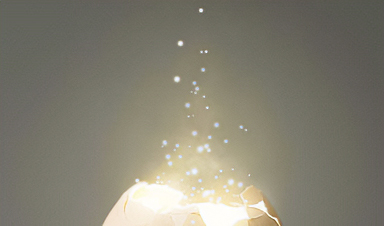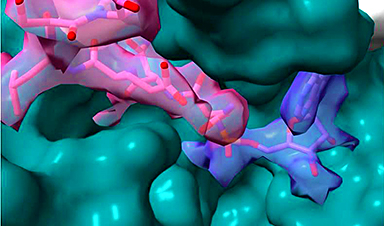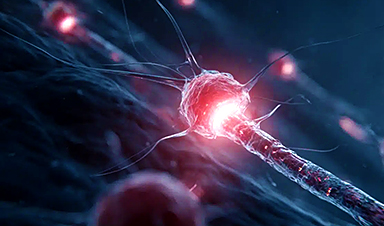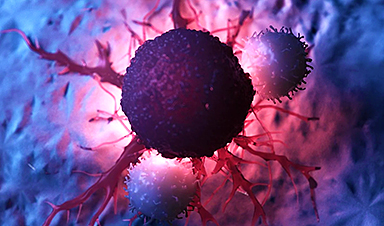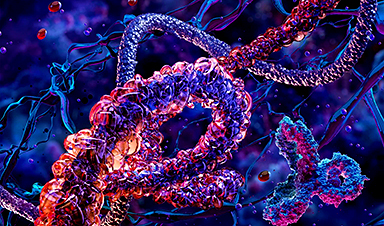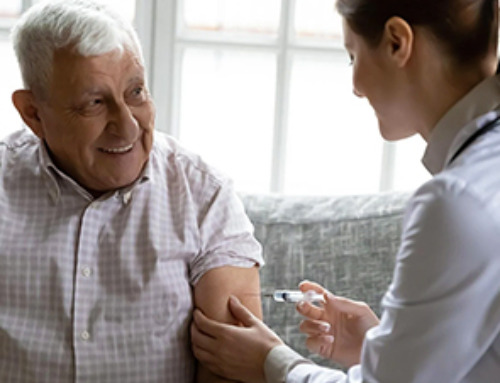Scientists have discovered a method to super-charge the ‘engine’ of sustainable fuel generation – by giving the materials a little twist.
The researchers, led by the University of Cambridge, are developing low-cost light-harvesting semiconductors that power devices for converting water into clean hydrogen fuel, using just the power of the sun. These semiconducting materials, known as copper oxides, are cheap, abundant and non-toxic, but their performance does not come close to silicon, which dominates the semiconductor market.
However, the researchers found that by growing the copper oxide crystals in a specific orientation so that electric charges move through the crystals at a diagonal, the charges move much faster and further, greatly improving performance. Tests of a copper oxide light harvester, or photocathode, based on this fabrication technique showed a 70% improvement over existing state-of-the-art oxide photocathodes, while also showing greatly improved stability.
The researchers say their results, reported in the journal Nature, show how low-cost materials could be fine-tuned to power the transition away from fossil fuels and toward clean, sustainable fuels that can be stored and used with existing energy infrastructure.
Challenges and Potential in Cuprous Oxide
Copper (I) oxide, or cuprous oxide, has been touted as a cheap potential replacement for silicon for years, since it is reasonably effective at capturing sunlight and converting it into electric charge. However, much of that charge tends to get lost, limiting the material’s performance.
“Like other oxide semiconductors, cuprous oxide has its intrinsic challenges,” said co-first author Dr Linfeng Pan from Cambridge’s Department of Chemical Engineering and Biotechnology. “One of those challenges is the mismatch between how deep light is absorbed and how far the charges travel within the material, so most of the oxide below the top layer of material is essentially dead space.”
“For most solar cell materials, it’s defects on the surface of the material that causes a reduction in performance, but with these oxide materials, it’s the other way round: the surface is largely fine, but something about the bulk leads to losses,” said Professor Sam Stranks, who led the research. “This means the way the crystals are grown is vital to their performance.”
To develop cuprous oxides to the point where they can be a credible contender to established photovoltaic materials, they need to be optimized so they can efficiently generate and move electric charges – made of an electron and a positively-charged electron ‘hole’ – when sunlight hits them.
Impact and Future Directions
One potential optimization approach is single-crystal thin films – very thin slices of material with a highly-ordered crystal structure, which are often used in electronics. However, making these films is normally a complex and time-consuming process.
Using thin film deposition techniques, the researchers were able to grow high-quality cuprous oxide films at ambient pressure and room temperature. By precisely controlling growth and flow rates in the chamber, they were able to ‘shift’ the crystals into a particular orientation. Then, using high temporal resolution spectroscopic techniques, they were able to observe how the orientation of the crystals affected how efficiently electric charges moved through the material.
“These crystals are basically cubes, and we found that when the electrons move through the cube at a body diagonal, rather than along the face or edge of the cube, they move an order of magnitude further,” said Pan. “The further the electrons move, the better the performance.”
“Something about that diagonal direction in these materials is magic,” said Stranks. “We need to carry out further work to fully understand why and optimise it further, but it has so far resulted in a huge jump in performance.” Tests of a cuprous oxide photocathode made using this technique showed an increase in performance of more than 70% over existing state-of-the-art electrodeposited oxide photocathodes.
“In addition to the improved performance, we found that the orientation makes the films much more stable, but factors beyond the bulk properties may be at play,” said Pan.
The researchers say that much more research and development is still needed, but this and related families of materials could have a vital role in the energy transition.
“There’s still a long way to go, but we’re on an exciting trajectory,” said Stranks. “There’s a lot of interesting science to come from these materials, and it’s interesting for me to connect the physics of these materials with their growth, how they form, and ultimately how they perform.”
Reference: “High carrier mobility along the [111] orientation in Cu2O photoelectrodes” by Linfeng Pan, Linjie Dai, Oliver J. Burton, Lu Chen, Virgil Andrei, Youcheng Zhang, Dan Ren, Jinshui Cheng, Linxiao Wu, Kyle Frohna, Anna Abfalterer, Terry Chien-Jen Yang, Wenzhe Niu, Meng Xia, Stephan Hofmann, Paul J. Dyson, Erwin Reisner, Henning Sirringhaus, Jingshan Luo, Anders Hagfeldt, Michael Grätzel and Samuel D. Stranks, 24 April 2024, Nature.
DOI: 10.1038/s41586-024-07273-8
The research was a collaboration with École Polytechnique Fédérale de Lausanne, Nankai University and Uppsala University. The research was supported in part by the European Research Council, the Swiss National Science Foundation, and the Engineering and Physical Sciences Research Council (EPSRC), part of UK Research and Innovation (UKRI). Sam Stranks is Professor of Optoelectronics in the Department of Chemical Engineering and Biotechnology, and a Fellow of Clare College, Cambridge.
News
New Once-a-Week Shot Promises Life-Changing Relief for Parkinson’s Patients
A once-a-week shot from Australian scientists could spare people with Parkinson’s the grind of taking pills several times a day. The tiny, biodegradable gel sits under the skin and releases steady doses of two [...]
Weekly injectable drug offers hope for Parkinson’s patients
A new weekly injectable drug could transform the lives of more than eight million people living with Parkinson's disease, potentially replacing the need for multiple daily tablets. Scientists from the University of South Australia [...]
Most Plastic in the Ocean Is Invisible—And Deadly
Nanoplastics—particles smaller than a human hair—can pass through cell walls and enter the food web. New research suggest 27 million metric tons of nanoplastics are spread across just the top layer of the North [...]
Repurposed drugs could calm the immune system’s response to nanomedicine
An international study led by researchers at the University of Colorado Anschutz Medical Campus has identified a promising strategy to enhance the safety of nanomedicines, advanced therapies often used in cancer and vaccine treatments, [...]
Nano-Enhanced Hydrogel Strategies for Cartilage Repair
A recent article in Engineering describes the development of a protein-based nanocomposite hydrogel designed to deliver two therapeutic agents—dexamethasone (Dex) and kartogenin (KGN)—to support cartilage repair. The hydrogel is engineered to modulate immune responses and promote [...]
New Cancer Drug Blocks Tumors Without Debilitating Side Effects
A new drug targets RAS-PI3Kα pathways without harmful side effects. It was developed using high-performance computing and AI. A new cancer drug candidate, developed through a collaboration between Lawrence Livermore National Laboratory (LLNL), BridgeBio Oncology [...]
Scientists Are Pretty Close to Replicating the First Thing That Ever Lived
For 400 million years, a leading hypothesis claims, Earth was an “RNA World,” meaning that life must’ve first replicated from RNA before the arrival of proteins and DNA. Unfortunately, scientists have failed to find [...]
Why ‘Peniaphobia’ Is Exploding Among Young People (And Why We Should Be Concerned)
An insidious illness is taking hold among a growing proportion of young people. Little known to the general public, peniaphobia—the fear of becoming poor—is gaining ground among teens and young adults. Discover the causes [...]
Team finds flawed data in recent study relevant to coronavirus antiviral development
The COVID pandemic illustrated how urgently we need antiviral medications capable of treating coronavirus infections. To aid this effort, researchers quickly homed in on part of SARS-CoV-2's molecular structure known as the NiRAN domain—an [...]
Drug-Coated Neural Implants Reduce Immune Rejection
Summary: A new study shows that coating neural prosthetic implants with the anti-inflammatory drug dexamethasone helps reduce the body’s immune response and scar tissue formation. This strategy enhances the long-term performance and stability of electrodes [...]
Scientists discover cancer-fighting bacteria that ‘soak up’ forever chemicals in the body
A family of healthy bacteria may help 'soak up' toxic forever chemicals in the body, warding off their cancerous effects. Forever chemicals, also known as PFAS (per- and polyfluoroalkyl substances), are toxic chemicals that [...]
Johns Hopkins Researchers Uncover a New Way To Kill Cancer Cells
A new study reveals that blocking ribosomal RNA production rewires cancer cell behavior and could help treat genetically unstable tumors. Researchers at the Johns Hopkins Kimmel Cancer Center and the Department of Radiation Oncology and Molecular [...]
AI matches doctors in mapping lung tumors for radiation therapy
In radiation therapy, precision can save lives. Oncologists must carefully map the size and location of a tumor before delivering high-dose radiation to destroy cancer cells while sparing healthy tissue. But this process, called [...]
Scientists Finally “See” Key Protein That Controls Inflammation
Researchers used advanced microscopy to uncover important protein structures. For the first time, two important protein structures in the human body are being visualized, thanks in part to cutting-edge technology at the University of [...]
AI tool detects 9 types of dementia from a single brain scan
Mayo Clinic researchers have developed a new artificial intelligence (AI) tool that helps clinicians identify brain activity patterns linked to nine types of dementia, including Alzheimer's disease, using a single, widely available scan—a transformative [...]
Is plastic packaging putting more than just food on your plate?
New research reveals that common food packaging and utensils can shed microscopic plastics into our food, prompting urgent calls for stricter testing and updated regulations to protect public health. Beyond microplastics: The analysis intentionally [...]

